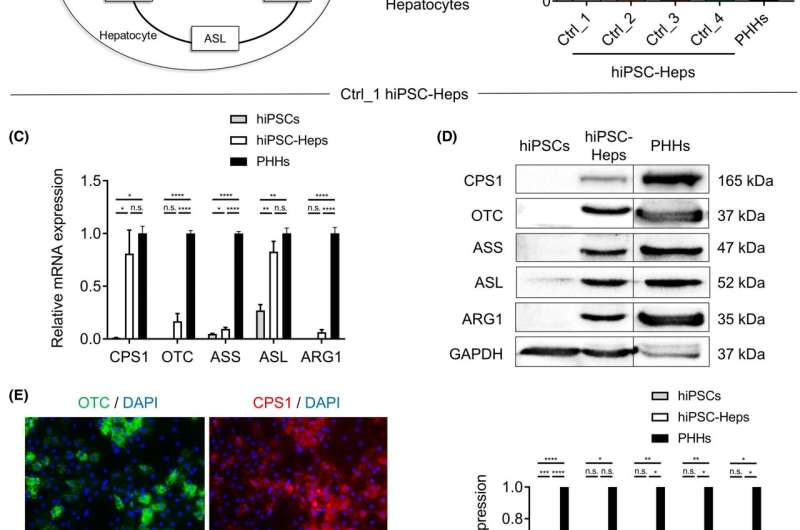Figure 1. Urea metabolism is impaired in patient-derived human-induced pluripotent stem cells (hiPSCs) differentiated into hepatocytes (hiPSC-Heps). (A) Scheme showing the urea cycle detoxifying ammonia (NH4+) into nontoxic urea in five consecutive urea cycle enzyme (UCE)–mediated reactions in mitochondria in hepatocytes. (B) Urea secretion in four control hiPSC-Hep lines (Ctrl_1-4) as compared with PHHs. Data represent the average of 4 to 12 independent biological samples. (C,D) Relative mRNA and protein expression of UCEs analyzed by real-time quantitative PCR (C) and western blot (D) in Ctrl_1 hiPSCs and hiPSC-Heps compared with primary human hepatocytes (PHHs). All samples shown were loaded on the same gel. The line indicates that the image was cropped. Data represent the average of two to four independent biological samples. One-way ANOVA; *p < 0.05, **p < 0.01, ***p < 0.001, and ****p < 0.0001. Error bars represent SEM. (E) Immunofluorescent images showing abundant mitochondrial expression and co-localization of carbamoyl phosphate synthetase 1 (CPS1) and ornithine transcarbamylase (OTC) in Ctrl_1 hiPSC-Heps. Nuclei are labeled with DAPI. Scale bar = 100 µM. Inset in merged image shown as bottom-right image. ARG1, arginase 1; ASL, argininosuccinate lyase; ASS, argininosuccinate synthetase; GAPDH, glyceraldehyde 3-phosphate dehydrogenase; n.s., not significant. Credit: DOI: 10.1002/hep.32247
The urea cycle is responsible for removing nitrogenous waste produced from the breakdown of protein in the organism. If the OTC enzyme is missing in this cycle, ammonia accumulation rises to toxic levels. An OTC deficiency is the most common disorder in the urea cycle. It could not be cured with drugs until now.
The OTC gene is located on the sex chromosome (X chromosome). This means that the manifestation of the disorder is usually weaker in female newborns. However, in male newborns, who have one X and one Y chromosome, a deficiency in the OTC gene has a dramatic effect: In newborn boys, ammonia toxicity due to OTC deficiency is often fatal. The research team looked for ways to test drugs in the lab against the OTC deficiency.
First, the research team generated liver cells from patients' skin tissue in an elaborate process. It worked like this: Initially, a tissue sample of the skin was taken from OTC-deficient patients as well as from a control group (healthy individuals). In a complex process, the samples were differentiated so that they functioned like stem cells. This engineering process was developed by Shin'Ya Yamanaka, for which he was awarded the Nobel Prize in Medicine in 2012.
"By using induced stem cell technology, we succeeded in generating liver cells that function largely like liver cells from patients," explains Dr. med. Alexander Lämmle, Senior Physician at the Department of Pediatrics and the University Institute of Clinical Chemistry at Inselspital. "However, we observed that the induced liver cells excrete significantly less urea than real, healthy liver cells, and this is independent of whether they originate from healthy controls or urea cycle patients."
The researchers were able to determine the reason for this behavior. The technologically engineered stem cells were characterized by a complete lack of aquaporin 9, a transport protein in the cell membrane. The reason for this deficiency is the still immature, fetal character of the artificial liver cells.
Aquaporin 9: The key to a functioning artificial liver cell
Aquaporins organize the transport of water and certain substances through the cell membrane. Aquaporin 9 is responsible for the transport of urea. In a next step, the researchers developed a process in which the formation of aquaporin 9 is induced in the stem cells. As a result, the technologically produced liver cells changed their behavior. They were able to break down ammonia into urea and excrete the urea—just as healthy cells do. This provides the basis for a functioning test procedure with artificial liver cells.
Use of artificial cells: Testing therapeutic agents
The OTC deficiency is characterized by the fact that the complex OTC protein structures do not function properly. They need—like most larger proteins—helpers or chaperones in order to assemble and function properly. Prof. Dr. med. Johannes Häberle at the Children Research Center at the University Hospital Zurich explains: "The chaperones ensure that the enzyme molecules are folded correctly and that the enzyme is correctly prepared for its use or reset afterwards. The new test model is now being used to test OTC chaperones to find out more about the OTC deficiency and, of course, about possible therapies."
More information: Alexander Laemmle et al, Aquaporin 9 induction in human i PSC ‐derived hepatocytes facilitates modeling of ornithine transcarbamylase deficiency, Hepatology (2021). DOI: 10.1002/hep.32247
Journal information: Hepatology
Provided by Inselspital, Bern University Hospital
























